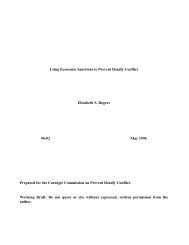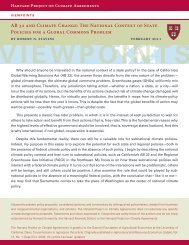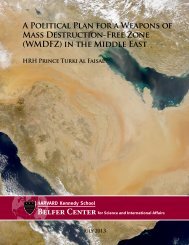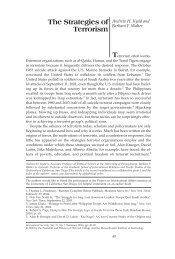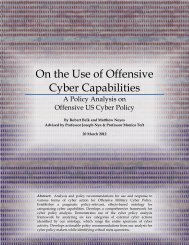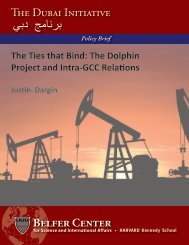Plutonium Mountain - Belfer Center for Science and International ...
Plutonium Mountain - Belfer Center for Science and International ...
Plutonium Mountain - Belfer Center for Science and International ...
- No tags were found...
You also want an ePaper? Increase the reach of your titles
YUMPU automatically turns print PDFs into web optimized ePapers that Google loves.
infrastructure <strong>and</strong> detritus of their mammoth Cold War weapons machine—the biological weapons<br />
factory at Stepnogorsk <strong>and</strong> the contaminated biological testing ground at Vozrozhdeniye<br />
Isl<strong>and</strong>, the chemical weapons facility at Pavlodar, <strong>and</strong> the Semipalatinsk nuclear testing polygon,<br />
among many others. In the case of Semipalatinsk, excessive secrecy prevented accountability<br />
within the Russian system so that materials were left unattended in the first place; it enabled<br />
complacency about the terrorism <strong>and</strong> proliferation risk posed by the unattended materials since<br />
very few people knew what was left behind <strong>and</strong> what risks it could pose; <strong>and</strong> it prevented key<br />
Russian decision makers from seizing the opportunity to act expeditiously when the US offered<br />
assistance.<br />
One of the great challenges of carrying out threat reduction in the years after the Soviet collapse<br />
was penetrating this secrecy <strong>and</strong> discovering the source of potential threats. It was a long,<br />
arduous process often made even more difficult by lack of cooperation or simple disorganization<br />
on the part of Russian authorities. Cooperation to beef up security at some sites was delayed<br />
by months or years over disputes over American access to the sites <strong>and</strong> what secrets might be<br />
revealed. Even today, continuing secrecy has blocked all cooperation to improve security at Russia’s<br />
nuclear weapons assembly <strong>and</strong> disassembly facilities, <strong>and</strong> there are no transparency measures<br />
<strong>for</strong> Russia’s giant fissile material storage facility at Mayak, leaving the United States in the<br />
dark as to its use, although it was largely built with U.S. funds.<br />
Many of the Russians were well aware of the dangers. At least some of them were interested in<br />
overcoming the mistrust of the past <strong>and</strong> addressing the threats. Through a step-by-step process<br />
of trust-building, many barriers were overcome; U.S. security experts visited <strong>and</strong> helped improve<br />
security at all but a few of the facilities in Russia where nuclear weapons <strong>and</strong> nuclear materials<br />
reside. But there were strong countervailing <strong>for</strong>ces in Russia—institutional <strong>and</strong> bureaucratic inertia,<br />
fears about spying, <strong>and</strong> a sense of national humiliation—that lingered long after the Soviet<br />
Union collapsed. The secrecy remained through the Yeltsin era <strong>and</strong> has become more intense<br />
in the Putin era in Russia. In the last two decades, there was never a thorough overhaul of the<br />
Soviet-Russian military-industrial complex, nor of the nuclear weapons complex or the secrecy<br />
in which they are shrouded.<br />
In the years immediately after the Soviet collapse, the Russians did not bother to alert Kazakhstan<br />
to the plutonium left behind at Degelen <strong>Mountain</strong> because it was a problem they did not<br />
want to address. They did not see it as a risk, at least until Hecker showed them the photographs<br />
of the metals scavenging. The secrecy alleviated the need <strong>for</strong> Russia to contribute financially to<br />
the clean-up. Although Russia could ill af<strong>for</strong>d the expense of a clean-up in the 1990s, its finances<br />
recovered in the 2000s <strong>and</strong> Russia could have made a major financial contribution. As successor<br />
to the Soviet nuclear arsenal, Russia must share responsibility <strong>for</strong> the site.<br />
An important lesson of the Degelen <strong>Mountain</strong> operation—a lesson that reverberates through all<br />
of the Cold War years—is the value <strong>and</strong> importance of seeking transparency. Facing the past is<br />
not easy <strong>for</strong> a country like Russia that suffered such an abrupt <strong>and</strong> turbulent collapse. It is hard to<br />
accept the idea of cooperation with a rich <strong>and</strong> powerful rival.<br />
Our point here is not to criticize those in the U.S. <strong>and</strong> Russia who have labored <strong>for</strong> years on<br />
threat reduction in the <strong>for</strong>mer Soviet Union—a two-decade-long ef<strong>for</strong>t that continues—but rather<br />
to highlight the lessons from their experiences. These lessons will be important <strong>for</strong> the next<br />
36<br />
<strong>Plutonium</strong> <strong>Mountain</strong>: Inside the 17-year mission to secure a dangerous legacy of Soviet nuclear testing



